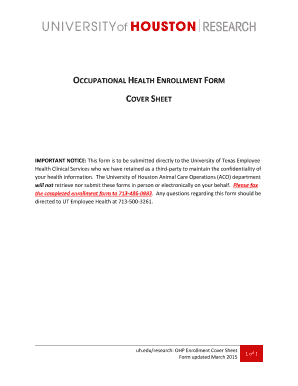Fill and Sign the Occupational Health Enrollment Form Uh

Practical advice on preparing your ‘Occupational Health Enrollment Form Uh’ online
Are you fed up with the annoyance of managing paperwork? Search no further than airSlate SignNow, the leading electronic signature solution for individuals and enterprises. Bid farewell to the lengthy process of printing and scanning files. With airSlate SignNow, you can easily finalize and endorse documents online. Utilize the robust capabilities embedded within this user-friendly and affordable platform and transform your method of paperwork organization. Whether you require to authorize forms or gather eSignatures, airSlate SignNow manages it all effortlessly, needing just a few clicks.
Adhere to this comprehensive guide:
- Access your account or sign up for a complimentary trial with our service.
- Click +Create to upload a document from your device, cloud, or our template collection.
- Open your ‘Occupational Health Enrollment Form Uh’ in the editor.
- Click Me (Fill Out Now) to finalize the document on your end.
- Incorporate and allocate fillable fields for others (if needed).
- Proceed with the Send Invite options to solicit eSignatures from others.
- Save, print your copy, or convert it into a reusable template.
Don’t be concerned if you need to work with your teammates on your Occupational Health Enrollment Form Uh or send it for notarization—our platform has everything you require to complete such tasks. Sign up with airSlate SignNow today and elevate your document management to a new level!
FAQs
-
What is the OCCUPATIONAL HEALTH ENROLLMENT FORM Uh and why is it important?
The OCCUPATIONAL HEALTH ENROLLMENT FORM Uh is a crucial document that captures essential health information of employees for workplace safety and compliance. It ensures that employers can assess health risks and implement appropriate measures to protect their workforce. Utilizing this form helps streamline the enrollment process and maintains accurate health records.
-
How does airSlate SignNow streamline the completion of the OCCUPATIONAL HEALTH ENROLLMENT FORM Uh?
airSlate SignNow simplifies the process of completing the OCCUPATIONAL HEALTH ENROLLMENT FORM Uh by allowing users to fill out and sign documents electronically. This eliminates the need for paper forms, reduces processing time, and minimizes errors in data entry. You can easily send the form to employees and track its completion in real-time.
-
What are the pricing options for using airSlate SignNow for the OCCUPATIONAL HEALTH ENROLLMENT FORM Uh?
airSlate SignNow offers flexible pricing plans that cater to businesses of all sizes looking to manage the OCCUPATIONAL HEALTH ENROLLMENT FORM Uh efficiently. You can choose from various subscription tiers that provide access to essential features, including eSigning, document templates, and integrations. A free trial is also available to explore the platform before committing.
-
Can I customize the OCCUPATIONAL HEALTH ENROLLMENT FORM Uh using airSlate SignNow?
Yes, airSlate SignNow allows you to customize the OCCUPATIONAL HEALTH ENROLLMENT FORM Uh to meet your specific requirements. You can add your company logo, modify fields, and include any additional questions that are relevant to your organization. This customization ensures that the form aligns with your branding and compliance needs.
-
What are the benefits of using airSlate SignNow for the OCCUPATIONAL HEALTH ENROLLMENT FORM Uh?
Using airSlate SignNow for the OCCUPATIONAL HEALTH ENROLLMENT FORM Uh offers numerous benefits, including improved efficiency, enhanced security, and reduced paperwork. The platform enables quick document turnaround, ensures secure storage of sensitive health information, and helps maintain compliance with occupational health regulations. This ultimately leads to a more organized and streamlined enrollment process.
-
Is it easy to integrate airSlate SignNow with existing HR systems for the OCCUPATIONAL HEALTH ENROLLMENT FORM Uh?
Absolutely! airSlate SignNow offers seamless integrations with various HR systems, making it easy to incorporate the OCCUPATIONAL HEALTH ENROLLMENT FORM Uh into your existing workflows. These integrations help automate data transfer and reduce manual entry, ensuring that employee health information is accurately captured and stored.
-
How can airSlate SignNow improve employee engagement with the OCCUPATIONAL HEALTH ENROLLMENT FORM Uh?
airSlate SignNow enhances employee engagement with the OCCUPATIONAL HEALTH ENROLLMENT FORM Uh by providing a user-friendly interface for completing forms. Employees can fill out and sign documents from any device at their convenience, which fosters a positive experience. This accessibility leads to higher completion rates and ensures timely enrollment.
Related searches to occupational health enrollment form uh
Find out other occupational health enrollment form uh
- Close deals faster
- Improve productivity
- Delight customers
- Increase revenue
- Save time & money
- Reduce payment cycles

